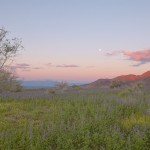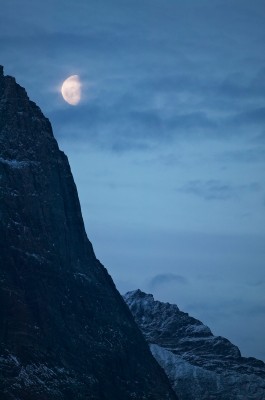One of the wonders of the night and twilight skies is the moon, and yet the moon can be a challenging subject to integrate into a landscape shot. There are several reasons for this, exposure problems, apparent size, depth of field, getting the moon near the horizon and subject movement all take their turns at making landscape photography with the moon a challenge. In this post, I’ll outline the different challenges in incorporating the moon into your landscape photography, and then provide some suggestions for how to work with these different limitations.
The first problem most people run into is the size problem. For a variety of reasons, we usually “see”, subjectively, the moon as larger than it is, in a pure angular sense, it’s actually quite small, perhaps half a degree in diameter. How big of a telephoto do you need to handle this? Well, if you spent over $100,000 on Canon’s biggest baddest EF lens and popped it onto a full-frame camera with a 2x teleextender, the moon would still probably barely but entirely fit in the view. That’s 2400mm of effective focal length, so if you include the moon in a 24mm image, you can guess that the moon is going to be a lot smaller (not quite 100 times smaller, but that’s not a bad guess) than the frame. If you imagine a big moon in a wide, wide landscape, you’re likely to be disappointed, the math just doesn’t work.
Thus, it’s natural to start looking at more telephoto shots that include the moon and the landscape, and this too creates problems. Even as short as 100mm, stopping down to f/32 and perfectly setting the focus distance at 34 feet will only allow you good focus from 17 feet down to infinity, and the moon is still small at that focal length. At longer focal lengths, mountaintops are usually the only subject you have any hope of including with a moon and keeping both in focus.
Exposure is also a challenge. You’ll be surprised by just how much brighter the moon is than anything else in a night landscape, it’s as bright as a light colored rock in full sunlight-which is precisely what it is! In fact, it’s so bright, that in a typical single-exposure type of shot (HDR and other mixing techniques notwithstanding), that it’s impossible to hold detail in the moon and the landscape in the night, you really need to work near dusk or dawn.
A desire to put the moon near the horizon (where it’ll be easier to include with that mountaintop we’ve almost limited ourselves to) during dawn or dus

k means, as a result of the geometry of these things, that you’ll usually need to be shooting near when the moon is full, when the moon rises at sunset and vice versa. Perhaps you can get alpenglow and the moon in the same shot, such as in this sunrise image from Joshua Tree. (There is a moon there, it’s quite small.)
“Snowy Pinnacles at Dusk”, above, makes use of many of these ideas, a rising moon (not full, the peak involved was very high in the sky above me, I was in a fjord) was taken handheld at ISO 400, 300mm, I think f/5. The closest peak is hundreds of yards away, the shot was made with a 300mm lens, and I was only barely able to keep both in focus, and just as importantly I was only barely able to hold detail in the moon and in the pinnacles, had the moon risen 30 minutes earlier I would have had a much easier time with the exposure range. While tricky, working through these challenges led me to creating what has proven to be a very popular image for me.
